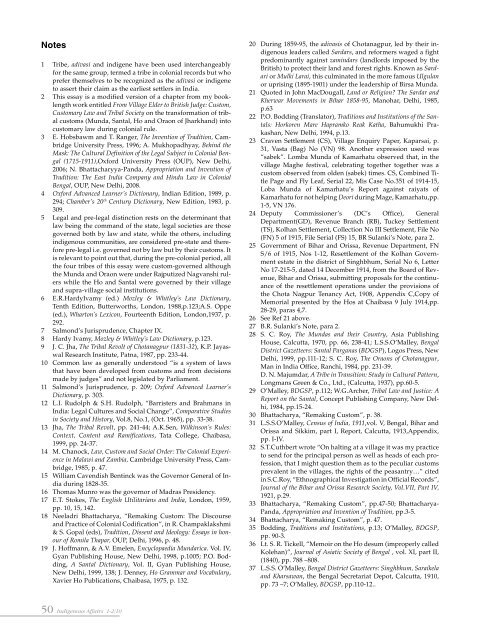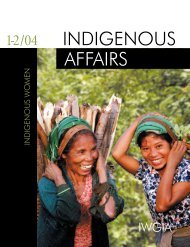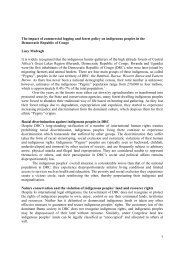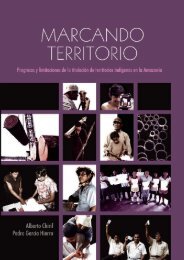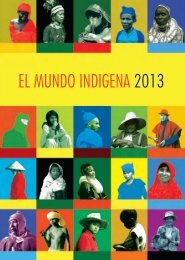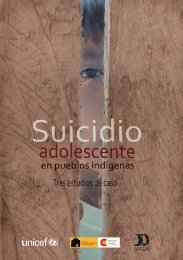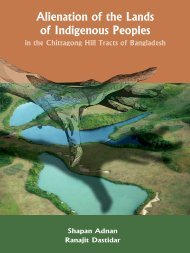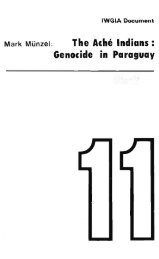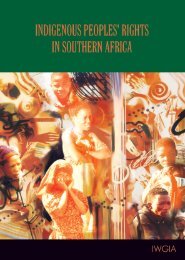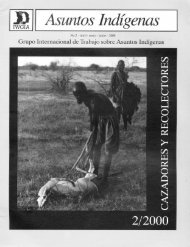Download (pdf) - iwgia
Download (pdf) - iwgia
Download (pdf) - iwgia
Create successful ePaper yourself
Turn your PDF publications into a flip-book with our unique Google optimized e-Paper software.
Notes<br />
1 Tribe, adivasi and indigene have been used interchangeably<br />
for the same group, termed a tribe in colonial records but who<br />
prefer themselves to be recognized as the adivasi or indigene<br />
to assert their claim as the earliest settlers in India.<br />
2 This essay is a modified version of a chapter from my booklength<br />
work entitled From Village Elder to British Judge: Custom,<br />
Customary Law and Tribal Society on the transformation of tribal<br />
customs (Munda, Santal, Ho and Oraon of Jharkhand) into<br />
customary law during colonial rule.<br />
3 E. Hobsbawm and T. Ranger, The Invention of Tradition, Cambridge<br />
University Press, 1996; A. Mukhopadhyay, Behind the<br />
Mask: The Cultural Definition of the Legal Subject in Colonial Bengal<br />
(1715-1911),Oxford University Press (OUP), New Delhi,<br />
2006; N. Bhattacharyya-Panda, Appropriation and Invention of<br />
Tradition: The East India Company and Hindu Law in Colonial<br />
Bengal, OUP, New Delhi, 2008.<br />
4 Oxford Advanced Learner’s Dictionary, Indian Edition, 1989, p.<br />
294; Chamber’s 20 th Century Dictionary, New Edition, 1983, p.<br />
309.<br />
5 Legal and pre-legal distinction rests on the determinant that<br />
law being the command of the state, legal societies are those<br />
governed both by law and state, while the others, including<br />
indigenous communities, are considered pre-state and therefore<br />
pre-legal i.e. governed not by law but by their customs. It<br />
is relevant to point out that, during the pre-colonial period, all<br />
the four tribes of this essay were custom-governed although<br />
the Munda and Oraon were under Rajputized Nagvanshi rulers<br />
while the Ho and Santal were governed by their village<br />
and supra-village social institutions.<br />
6 E.R.HardyIvamy (ed.) Mozley & Whitley’s Law Dictionary,<br />
Tenth Edition, Butterworths, London, 1988,p.123;A.S. Oppe<br />
(ed.), Wharton’s Lexicon, Fourteenth Edition, London,1937, p.<br />
292.<br />
7 Salmond’s Jurisprudence, Chapter IX.<br />
8 Hardy Ivamy, Mozley & Whitley’s Law Dictionary, p.123.<br />
9 J. C. Jha, The Tribal Revolt of Chotanagpur (1831-32), K.P. Jayaswal<br />
Research Institute, Patna, 1987, pp. 233-44.<br />
10 Common law as generally understood “is a system of laws<br />
that have been developed from customs and from decisions<br />
made by judges” and not legislated by Parliament.<br />
11 Salmond’s Jurisprudence, p. 209; Oxford Advanced Learner’s<br />
Dictionary, p. 303.<br />
12 L.I. Rudolph & S.H. Rudolph, “Barristers and Brahmans in<br />
India: Legal Cultures and Social Change”, Comparative Studies<br />
in Society and History, Vol.8, No.1, (Oct. 1965), pp. 33-38.<br />
13 Jha, The Tribal Revolt, pp. 241-44; A.K.Sen, Wilkinson’s Rules:<br />
Context, Content and Ramifications, Tata College, Chaibasa,<br />
1999, pp. 24-37.<br />
14 M. Chanock, Law, Custom and Social Order: The Colonial Experience<br />
in Malawi and Zambia, Cambridge University Press, Cambridge,<br />
1985, p. 47.<br />
15 William Cavendish Bentinck was the Governor General of India<br />
during 1828-35.<br />
16 Thomas Munro was the governor of Madras Presidency.<br />
17 E.T. Stokes, The English Utilitarians and India, London, 1959,<br />
pp. 10, 15, 142.<br />
18 Neeladri Bhattacharya, “Remaking Custom: The Discourse<br />
and Practice of Colonial Codification”, in R. Champaklakshmi<br />
& S. Gopal (eds), Tradition, Dissent and Ideology: Essays in honour<br />
of Romila Thapar, OUP, Delhi, 1996, p. 48.<br />
19 J. Hoffmann, & A.V. Emelen, Encyclopaedia Mundarica. Vol. IV,<br />
Gyan Publishing House, New Delhi, 1998, p.1005; P.O. Bodding,<br />
A Santal Dictionary, Vol. II, Gyan Publishing House,<br />
New Delhi, 1999, 138; J. Denney, Ho Grammar and Vocabulary,<br />
Xavier Ho Publications, Chaibasa, 1975, p. 132.<br />
20 During 1859-95, the adivasis of Chotanagpur, led by their indigenous<br />
leaders called Sardars, and reformers waged a fight<br />
predominantly against zamindars (landlords imposed by the<br />
British) to protect their land and forest rights. Known as Sardari<br />
or Mulki Larai, this culminated in the more famous Ulgulan<br />
or uprising (1895-1901) under the leadership of Birsa Munda.<br />
21 Quoted in John MacDougall, Land or Religion? The Sardar and<br />
Kherwar Movements in Bihar 1858-95, Manohar, Delhi, 1985,<br />
p.63<br />
22 P.O. Bodding (Translator), Traditions and Institutions of the Santals:<br />
Horkoren Mare Hapramko Reak Katha, Bahumukhi Prakashan,<br />
New Delhi, 1994, p.13.<br />
23 Craven Settlement (CS), Village Enquiry Paper, Kaparsai, p.<br />
31, Vasta (Bag) No (VN) 98. Another expression used was<br />
“sabek”. Lomba Munda of Kamarhatu observed that, in the<br />
village Maghe festival, celebrating together together was a<br />
custom observed from olden (sabek) times. CS, Combined Title<br />
Page and Fly Leaf, Serial 22, Mis Case No.351 of 1914-15,<br />
Loba Munda of Kamarhatu’s Report against raiyats of<br />
Kamarhatu for not helping Deori during Mage, Kamarhatu,pp.<br />
1-5, VN 176.<br />
24 Deputy Commissioner’s (DC’s Office), General<br />
Department(GD), Revenue Branch (RB), Tuckey Settlement<br />
(TS), Kolhan Settlement, Collection No III Settlement, File No<br />
(FN) 5 of 1915, File Serial (FS) 15, BR Sulanki’s Note, para 2.<br />
25 Government of Bihar and Orissa, Revenue Department, FN<br />
S/6 of 1915, Nos 1-12, Resettlement of the Kolhan Government<br />
estate in the district of Singhbhum, Serial No 6, Letter<br />
No 17-215-5, dated 14 December 1914, from the Board of Revenue,<br />
Bihar and Orissa, submitting proposals for the continuance<br />
of the resettlement operations under the provisions of<br />
the Chota Nagpur Tenancy Act, 1908, Appendix C,Copy of<br />
Memorial presented by the Hos at Chaibasa 9 July 1914,pp.<br />
28-29, paras 4,7.<br />
26 See Ref 21 above.<br />
27 B.R. Sulanki’s Note, para 2.<br />
28 S. C. Roy, The Mundas and their Country, Asia Publishing<br />
House, Calcutta, 1970, pp. 66, 238-41; L.S.S.O’Malley, Bengal<br />
District Gazetteers: Santal Parganas (BDGSP), Logos Press, New<br />
Delhi, 1999, pp.111-12; S. C. Roy, The Oraons of Chotanagpur,<br />
Man in India Office, Ranchi, 1984, pp. 231-39.<br />
D. N. Majumdar, A Tribe in Transition: Study in Cultural Pattern,<br />
Longmans Green & Co., Ltd., (Calcutta, 1937), pp.60-5.<br />
29 O’Malley, BDGSP, p.112; W.G.Archer, Tribal Law and Justice: A<br />
Report on the Santal, Concept Publishing Company, New Delhi,<br />
1984, pp.15-24.<br />
30 Bhattacharya, “Remaking Custom”, p. 38.<br />
31 L.S.S.O’Malley, Census of India, 1911,vol. V, Bengal, Bihar and<br />
Orissa and Sikkim, part I, Report, Calcutta, 1913,Appendix,<br />
pp. I-IV.<br />
32 S.T.Cuthbert wrote “On halting at a village it was my practice<br />
to send for the principal person as well as heads of each profession,<br />
that I might question them as to the peculiar customs<br />
prevalent in the villages, the rights of the peasantry…” cited<br />
in S.C.Roy, “Ethnographical Investigation in Official Records”,<br />
Journal of the Bihar and Orissa Research Society, Vol.VII, Part IV,<br />
1921, p.29.<br />
33 Bhattacharya, “Remaking Custom”, pp.47-50; Bhattacharya-<br />
Panda, Appropriation and Invention of Tradition, pp.3-5.<br />
34 Bhattacharya, “Remaking Custom”, p. 47.<br />
35 Bodding, Traditions and Institutions, p.13; O’Malley, BDGSP,<br />
pp. 90-3.<br />
36 Lt. S. R. Tickell, “Memoir on the Ho desum (improperly called<br />
Kolehan)”, Journal of Asiatic Society of Bengal , vol. XI, part II,<br />
(1840), pp. 788 –808.<br />
37 L.S.S. O’Malley, Bengal District Gazetteers: Singhbhum, Saraikela<br />
and Kharsawan, the Bengal Secretariat Depot, Calcutta, 1910,<br />
pp. 73 –7; O’Malley, BDGSP, pp.110-12..<br />
50 Indigenous Affairs 1-2/10


